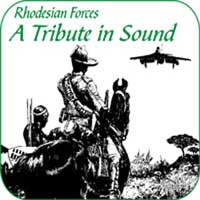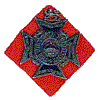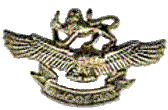|
||||||||||||||
|
A Listener Comments Quality wise, the disc is excellent. In terms of its content, it's what I was looking for - it's wonderful that so many of the Rhodesian military marches and parade cadences and so on have been recorded. While I never experienced Rhodesia myself (though my parents did), these discs, DVDs and many books ensure that Rhodesia and the people who fought to make her the beacon of democracy and civilisation in Africa that she was, will never be forgotten. Keep up the great work! Joshua Bell (22) - South Australia |
||||||||||||||
|
Forces Represented |
||||||||||||||
| British
South Africa Police
The BSAP was formed from the British South Africa Company Police and saw the light of day in 1897. It was accorded regimental status as Rhodesia's first line of defence in these early and turbulent times. The BSAP grew from strength to strength and was an integral part of the history of Rhodesia itself |
|
|||||||||||||
|
|
Rhodesian
African Rifles
The RAR was
raised as 1 Rhodesian Native Regiment for service in
Tanganyika in World War One. In World War 2 the regiment was
reraised as the Rhodesian African Rifles and saw extensive
service in Burma where it was very successful against the
Japanese. In 1956 the RAR deployed to Malaya and once again
proved its mettle in combat. It formed part of the fireforce
concept during the Rhodesian War and served throughout the
country as an Infantry Regiment |
|||||||||||||
| Rhodesian
Corps of Signals
The Rhodesian Corps of Signals band formed part of the corps and was another very important part of ceremonial activities within the Rhodesian Army. The corps itself was responsible for the provision of communications throughout the army and was originally raised as No 1 Signals Company during World War Two. The band wore a distinctive white Busby on certain ceremonial occasions, making them stand out on parade
|
|
|||||||||||||
|
|
Rhodesian
Light Infantry
The 1st
Battalion RLI was established in 1961 as a result of the need
for a regular infantry battalion to defend the Federal borders.
The RLI quickly gained an excellent reputation as a fighting
unit and when it converted to a commando style of operation, this reputation
increased. Prime Minister Ian Smith rightly toasted them
'The Incredibles' due to their operational
successes in the field |
|||||||||||||
| Rhodesian
Special Air Service
The SAS was Rhodesia's elite special force regiment and first saw the light of day when Rhodesians served with distinction during the Second World War as part of the British SAS in the desert and in Italy. In 1961 the SAS was reformed in Northern Rhodesia and then transferred to Salisbury. C Squadron, Rhodesian SAS saw service in Aden thereafter and during Rhodesia's bush war accounted for many of the enemy on operations in Mozambique, Zambia and at home |
|
|||||||||||||
|
|
Selous
Scouts
General Walls
requested the formation of an elite tracking unit in 1974 and
thus the Selous Scouts was born. Lt Col Ron Reid Daly was the
founder of the unit and took it from establishment to maturity.
The unit used a variety of Special Force tactics and were
famous for their role in 'Pseudo Operations'. The Selous Scouts accounted for many of the enemy in the ongoing
bush war, working closely with the RLI, the SAS and the BSAP Special
Branch |
|||||||||||||
| Rhodesia
Regiment
The Rhodesia Regiment is synonymous with the history of the country itself. It was originally raised in the 1890s to defend the population of new country against rebel forces and continued to serve the nation and the crown through both world wars. Most Rhodesians did their National Service in the Regiment and battalions and independent companies were deployed throughout Rhodesia during the war
|
|
|||||||||||||
|
|
Rhodesian
Air Force
The birth of the RRAF was at Belvedere airport in Salisbury in 1935 when a Territorial Reserve Air Unit was formed and pilot training on Tiger Moths commenced. The RhAF developed after the second world war and finally consisted of 8 squadrons by the end of the bush war. It accounted for many of the enemy, the 'Green Leader' operational sortie into Zambia being one of the more famous |
|||||||||||||
|
|
||||||||||||||
|
|
||||||||||||||









